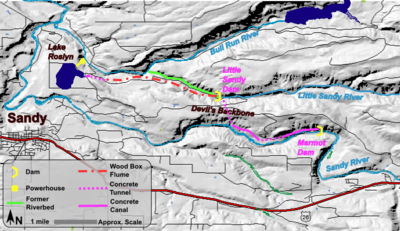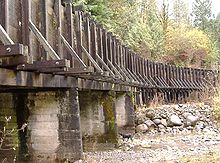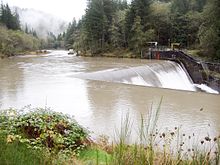- Bull Run Hydroelectric Project
-
The Bull Run Hydroelectric Project was a Portland General Electric (PGE) development in the Sandy River basin in the U.S. state of Oregon. Originally built between 1908 and 1912 near the town of Bull Run, it supplied hydroelectric power for the Portland area for nearly a century, until it was removed in 2007 and 2008. The project used a system of canals, tunnels, wood box flumes and diversion dams to feed a remote storage reservoir and powerhouse. The entire project was removed because of rising environmental costs. Marmot Dam on the Sandy River was demolished in 2007, and the Little Sandy Dam on the Little Sandy River was taken down in 2008.
Contents
History and overview
The Mount Hood Railway and Power Company (MHR&P), also known as the Mount Hood Company, began the project in 1906, building the Little Sandy Dam to divert water through a wooden flume, about 3.2 miles (5.1 km) long, to Roslyn Lake.[1] The dam reduced streamflows on the lower 1.7 miles (2.7 km) of the Little Sandy River and blocked all salmon and steelhead access to the upper 6.5 miles (10.5 km) of the river.[1] Roslyn Lake was at 656 feet (200 m) above sea level,[2] about 400 feet (120 m) higher than the mouth of the Bull Run River, at 242 feet (74 m).[3] The 140-acre (0.57 km2) lake acted as a reservoir for the powerhouse, which was completed and put into operation in 1912, the same year that the MHR&P merged with Portland Railway, Light and Power Company (PRL&P), the predecessor of PGE.[1]
In 1913 PRL&P built a dam on the Sandy River to supplement the Little Sandy Dam. The Marmot Dam, 30 feet (9.1 m) high, diverted water from the Sandy to the Little Sandy by canal and tunnel, the longest of which ran 4,690 feet (1,430 m) under the ridge between the two rivers. The new dam supplied up to 600 cubic feet per second (17 m3/s) to the Little Sandy above its diversion dam, and the Little Sandy provided up to 200 cubic feet per second (5.7 m3/s), all of which could be diverted through the flume to Roslyn Lake.[1]
The Marmot Dam included a fish ladder to allow migration of salmon and steelhead; however it performed poorly at first and required frequent upgrades and maintenance, which continued into the 1990s. To prevent fish from being swept into the diversion canal, PGE installed fish screens in 1951 and later added a bypass system to rescue fish trapped in the canal..[4]
In 1989 the original timber crib Marmot Dam was replaced with a concrete structure.
Operations
Feature Location Marmot Dam 45°23′59″N 122°07′56″W / 45.39969°N 122.13233°W Little Sandy Dam 45°24′54″N 122°10′39″W / 45.41492°N 122.17757°W Bull Run Hydro powerhouse 45°25′44″N 122°14′02″W / 45.42901°N 122.23395°WCoordinates: 45°25′44″N 122°14′02″W / 45.42901°N 122.23395°W The powerhouse had a generating capacity of 22 megawatts (MW), enough to power 12,000 homes in 2007.[5]
Facts
Generating capacity 22 MW FERC license No. 477 Average power generation 13 MW Average annual power generation 110,000 MW·h (400 TJ) Electrical power value at $0.06/kW·h $6,600,000 Sandy River water supply 600 ft³/s (17 m³/s) (max) Little Sandy River water supply 100% Flume capacity 900 ft³/s (25 m³/s) (in any combination of Sandy or Little Sandy water) Lake surface area 160 acres (650,000 m²) Usable storage capacity 928 acre feet (1,145,000 m3) Penstocks 2 × 1,200 ft (0.61 × 370 m), 9 ft (2.7 m) diameter Hydraulic head 320 ft (98 m or 960 kPa) Turbines 4 Decommissioning
Time lapse video of Dam removal.
The decommissioning project required significant oversight, because Marmot Dam was the largest concrete dam ever removed in the United States.[6] PGE sought and received initial approval for the project from the Federal Energy Regulatory Commission (FERC) in 1999. PGE later employed RESOLVE, a non-profit dispute resolution organization, to help develop a detailed consensus plan among the interested parties. An agreement was reached in 2002 on the decommissioning.[7] The primary issues addressed by the reviews were the impact on fish species (particularly salmonids), their habitat, and the effect of the release of 1 million cubic yards (750,000 cubic meters) of sediment on the river course.[8][9][10] In 2004, PGE allowed its operating license to lapse, and filed a notice stating: "[...]the likely cost of providing the necessary level of protection, mitigation, and enhancement for the resources affected by the Project would outweigh the economic benefit of generation at the Project over the life of a new license[...]"[7] The project continued to operate with license extensions while decommissioning awaited approval. In 2006, PGE requested special approval of the decommissioning from the National Marine Fisheries Service, because of the project's potential impact on coho salmon. The final review was conducted by the United States Army Corps of Engineers, which granted approval for the decommissioning on May 21, 2007. A spokesman for the Corps stated that the removal project was unusual, because "Large dams usually don't get removed."[8]
Before Marmot Dam could be removed, a temporary coffer dam had to be built upstream. When this phase of the project was complete, the removal of the permanent concrete dam could proceed. The destruction of the permanent dam began on 26 July 2007, when a public controlled demolition weakened the structure. The rest of the dam was destroyed using pneumatic hammers over approximately 4 months.[11] The last concrete from Marmot Dam was removed on September 30, 2007,[12] and the final phase of removal was completed on 20 October 2007, when the temporary earthen dam washed away and the Sandy River began to flow freely for the first time since 1912.[13]
PGE removed Little Sandy Dam in 2008, eliminating Roslyn Lake. This restored Little Sandy River flow and made salmon and steelhead migration once again possible.[14] In May 2009, a fish biologist reported that salmon and steelhead were spawning upstream of the former dam.[15] PGE donated 1,500 acres (6.1 km2) of the dam site to the Western Rivers Conservancy.[14] This land is planned to form the core of a 9,000-acre (36 km2) natural refuge and public recreation area, which will be managed by the Bureau of Land Management.[14] PGE's water rights on the river were transferred to the state.[16] As of 2009, PGE biologists continue to monitor the streams.[14]
As part of its decommissioning, PGE planned to demolish the powerhouse until a private company offered to buy it.[17] Powerhouse Re Gen LLC, a group of historic preservationists, have agreed to acquire the building, which is eligible for listing on the National Register of Historic Places. According to the Daily Journal of Commerce of February 2, 2010, although PGE and Re Gen have agreed on the purchase, Re Gen must first seek approval from Clackamas County, complete an environmental study of the site, and seek approval from FERC.[18] Re Gen, which has not announced specific plans for the site, plans to preserve it as well as other structures near Roslyn Lake.[17]
References
- ^ a b c d Taylor, pp. 21–22
- ^ "Roslyn Lake". Geographic Names Information System (GNIS). United States Geological Survey. November 28, 1980. http://geonames.usgs.gov/pls/gnispublic/f?p=gnispq:3:::NO::P3_FID:1148735. Retrieved January 16, 2010.
- ^ "Bull Run River". Geographic Names Information System (GNIS). United States Geological Survey. November 28, 1980. http://geonames.usgs.gov/pls/gnispublic/f?p=gnispq:3:::NO::P3_FID:1138921. Retrieved January 16, 2010.
- ^ Taylor, pp. 22–24
- ^ Editorial staff (July 29, 2007). "A river released to the wild". The Oregonian: p. E04. http://0-docs.newsbank.com.catalog.multcolib.org/openurl?ctx_ver=z39.88-2004&rft_id=info:sid/iw.newsbank.com:NewsBank:ORGB&rft_val_format=info:ofi/fmt:kev:mtx:ctx&rft_dat=11ABC3E11630C940&svc_dat=InfoWeb:aggregated4&req_dat=0D10F2CADB4B24C0.
- ^ McOmie, Grant (April 11, 2005). "2 the Outdoors - Marmot Dam Comes Down Soon". KATU news. Archived from the original on April 16, 2005. http://web.archive.org/web/20050416121835/http://www.katu.com/outdoor/story.asp?ID=76402. Retrieved June 11, 2008. "When the dam removal begins it will be the largest concrete dam in America to come down."
- ^ a b "Decommissioning Plan for the Bull Run Hydroelectric Project, FERC Project No. 447" (PDF). Portland General Electric. November 2002. Archived from the original on September 28, 2007. http://web.archive.org/web/20070928065333/http://www.portlandgeneral.com/about_pge/news/sandy_land/decommissioning_plan.pdf. Retrieved February 9, 2010.
- ^ a b Tucker, Libby (May 24, 2007). "Bull Run dam removal poses engineering challenges". Daily Journal of Commerce. http://findarticles.com/p/articles/mi_qn4184/is_20070524/ai_n19186243. Retrieved November 18, 2007.
- ^ Numerical Modeling of Sediment Transport in the Sandy River, OR Following Removal of Marmot Dam, Technical Report prepared for PGE by Stillwater Sciences, March 2000. ( 3.7MB pdf)
- ^ Evaluation of Geomorphic Effects of Removal of Marmot and Little Sandy Dams and Potential Impacts on Anadromous Salmonids, Technical Report prepared for PGE by Stillwater Sciences, March 2000. ( 2.1MB pdf)
- ^ Sarma, Daisy (July 27, 2007). "Blasts Spell Beginning of the End for Marmot Dam". The Money Times. http://www.themoneytimes.com/articles/20070726/blasts_spell_beginning_of_the_end_for_marmot_dam-id-107103.html.
- ^ "Dam Removal Project". Portland General Electric. 2007. Archived from the original on September 28, 2007. http://web.archive.org/web/20070928065242/http://www.portlandgeneral.com/community_and_env/hydropower_and_fish/sandy/dam_removal.asp. Retrieved November 18, 2007.
- ^ "Rain helps Sandy River run wild, free". The Oregonian. October 29, 2007. http://www.oregonlive.com/news/oregonian/index.ssf?/base/news/1192935309261960.xml&coll=7.
- ^ a b c d "Sandy River". Portland General Electric. http://www.portlandgeneral.com/community_environment/initiatives/protecting_fish/sandy_river/default.aspx. Retrieved December 18, 2009.
- ^ Strobel, Burke. "Successful Salmon Spawning in Little Sandy River". Portland Water Bureau. http://www.portlandonline.com/water/index.cfm?a=244029&c=43032. Retrieved December 18, 2009.
- ^ Brinckman, Jonathan (October 12, 2002). "PGE will remove 2 dams in basin of Sandy River". The Oregonian (The Foundation for Water and Energy Education (FWEE)). http://www.fwee.org/news/getStory?story=973. Retrieved December 18, 2009.
- ^ a b "Preservation group reaches agreement with PGE to acquire Bull Run Powerhouse". PGE. http://www.portlandgeneral.com/our_company/news_issues/news/02_02_2010_preservation_group_reaches_ag.aspx. Retrieved February 9, 2010.
- ^ Weinstein, Nathalie. "Preservationist group purchases Powerhouse". Daily Journal of Commerce. http://djcoregon.com/news/2010/02/02/portlands-past-preserved-with-powerhouse-purchase-enrgy/. Retrieved February 9, 2010.
Works cited
- Taylor, Barbara (1998). "Salmon and Steelhead Runs and Related Events of the Sandy River Basin – A Historical Perspective". Portland, Oregon: Portland General Electric Company. Retrieved January 16, 2010.
External links
- Settlement Agreement Concerning the Removal of the Bull Run Hydroelectric Project..., PGE and interested parties, October 24, 2002. ( 1.2MB pdf)
- Clean Water Act § 401 Certification Evaluation and Finding Report For the Decommissioning of the Bull Run Hydroelectric Project (FERC No. 477), Sandy River Basin, Clackamas County, Oregon 1.2MB pdf.
- McOmie, Grant (2005-04-11). "Marmot Dam Comes Down Soon". KATU News. Archived from the original on 2005-04-16. http://web.archive.org/web/20050416121835/http://www.katu.com/outdoor/story.asp?ID=76402.
- Restoring the Sandy River Basin (American Rivers)
- Taylor, William Thomas; Daniel Harvey Braymer (1917). American Hydroelectric Practice. McGraw-Hill Book Company. pp. 123–124. http://books.google.com/books?id=vBYhAAAAMAAJ.
Categories:- Buildings and structures in Clackamas County, Oregon
- Dams in Oregon
- Hydroelectric power plants in Oregon
- Former hydroelectric power plants in the United States
Wikimedia Foundation. 2010.




